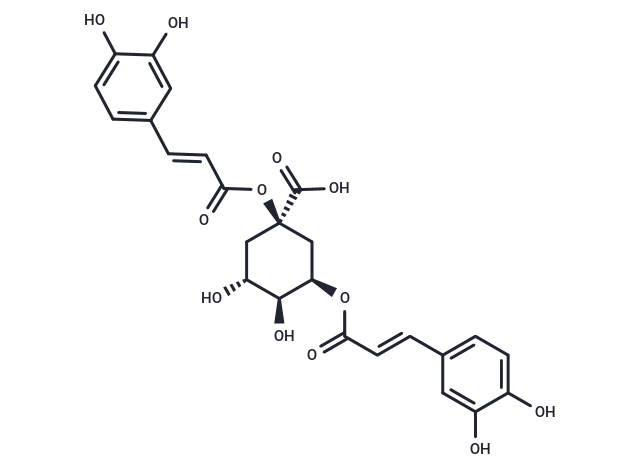Shopping Cart
- Remove All
 Your shopping cart is currently empty
Your shopping cart is currently empty

Cynarin (1,5-Dicaffeoylquinic acid) has neuroprotective, and antioxidant effects, it can inhibition of GSK3β as well as the modulation of Bcl-2/Bax.

| Pack Size | Price | Availability | Quantity |
|---|---|---|---|
| 1 mg | $39 | In Stock | |
| 2 mg | $52 | In Stock | |
| 5 mg | $68 | In Stock | |
| 10 mg | $113 | In Stock | |
| 25 mg | $213 | In Stock | |
| 50 mg | $322 | In Stock | |
| 1 mL x 10 mM (in DMSO) | $78 | In Stock |
| Description | Cynarin (1,5-Dicaffeoylquinic acid) has neuroprotective, and antioxidant effects, it can inhibition of GSK3β as well as the modulation of Bcl-2/Bax. |
| In vitro | Cynarinhas protective effects against MPP~+ induces neurotoxicity of PC12 Cells, it (50 umol/L) pretreatment can inhibit the MPP+-induced up-regulation of the expression of α-synuclein mRNA and protein.1, 5-diCQA has antioxidant signaling properties that upregulate GSH synthesis by stimulating the Nrf2 pathway in astrocytes and protects them from cell death in an in vitro model of ischemia/reperfusion[1].Cynarindecreases the expression and protein levels of inducible nitric oxide synthase (iNOS) when used at a concentration of 10 μM in human coronary artery smooth muscle cells (HCASMCs) treated with a cytokine mixture[2]. |
| Kinase Assay | The processing of an in vitro model of ischemia/reperfusion was described previously. The cultures were washed three times with deoxygenated glucose-free DMEM and placed into an anaerobic chamber with an atmosphere of 10% H2, 85% N2, and 5% CO2 for 4 h. Then the glucose-free DMEM was replaced with complete medium, and the culture plates were maintained at 37 C in a humidified 5% CO2-containing atmosphere for an additional 20 h. As a pretreatment, different concentrations of 1, 5-diCQA were added to the media before OGD for 2 h[1]. |
| Alias | Cynarine, Cyclohexanecarboxylic acid, 1,3-bis[[3-(3,4-dihydroxyphenyl)-1-oxo-2-propen-1-yl]oxy]-4,5-dihydroxy-, (1R,3R,4S,5R)-, 1,5-Dicaffeoylquinic acid |
| Molecular Weight | 516.45 |
| Formula | C25H24O12 |
| Cas No. | 30964-13-7 |
| Smiles | O[C@@H]1C[C@](C[C@@H](OC(=O)\C=C\c2ccc(O)c(O)c2)[C@H]1O)(OC(=O)\C=C\c1ccc(O)c(O)c1)C(O)=O |
| Relative Density. | 1.64 g/cm3 |
| Storage | keep away from moisture | Powder: -20°C for 3 years | In solvent: -80°C for 1 year | Shipping with blue ice. | |||||||||||||||||||||||||
| Solubility Information | DMSO: 23 mg/mL (44.53 mM), Sonication is recommended. | |||||||||||||||||||||||||
Solution Preparation Table | ||||||||||||||||||||||||||
DMSO
| ||||||||||||||||||||||||||

Copyright © 2015-2025 TargetMol Chemicals Inc. All Rights Reserved.